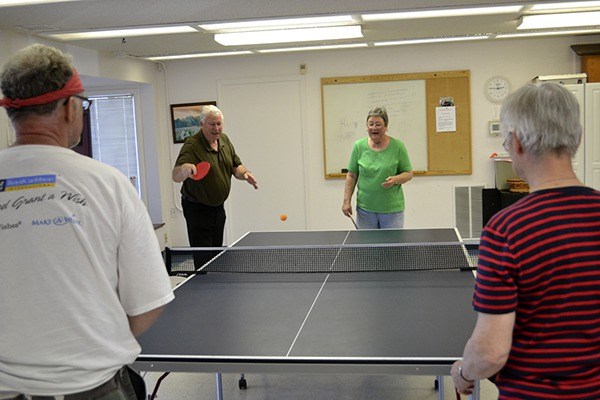The population is aging toward the younger at the Shipley Center, 921 E. Hammond St. in Sequim.
In 10 years, the average age for a member has gone down by about seven years from 78.8 to 71.8, center officials report.
With the shift, membership has gone up significantly as well from about 1,000 members in 2006 to 1,896 today.
“It’s not that less people in their 70s or 80s are coming,” said Michael Smith, executive director of the center. “We’re adding a younger group in their 60s and 70s.”
Michelle Rhodes, development and programs director, said the center has been attracting a younger group with more physically active classes and trips such as tai chi and ping pong.
An exercise class can draw up to 50 people three times a week in the main activity room, she said.
“We still have traditional older senior activities like knitting, bingo, crocheting and bridge,” she said. “As we do get older we become more concerned about mobility so it’s important to offer a wide range of activities.”
But as the center booms, space and scheduling constrict.
Rhodes said the only times available for new or expanded classes are some Tuesdays, Friday afternoons and on weekends.
“We’re nearing capacity and it’s making it obvious we need a new building,” Smith said.
“We do wonderful stuff but we need more room to do it.”
Planning ahead
The center’s board of directors decided in 2007 they’d need more space and began investigating costs for a new facility.
In 2010, the center purchased 4.5 acres of land on the Discovery Trail near Washington Street and the Simdars Road exit with financial assistance from R. Leo Shipley and in 2012 added an adjacent 1.3 acres with members’ donations for a total of $261,000 between the two properties.
Smith said a conceptual design from architect Roy Hellwig estimated a new facility at $10.4 million.
It would feature more space, rooms, a gymnasium, walking track and more.
But since the conceptual plan was unveiled, officials say there have been some false impressions.
“We’ve heard concerns we’re not going to continue certain activities when we move to a new building,” Smith said.
“We’re always going to do an activity if there’s enough people to do it. We’ll keep doing those but be able to add pickleball, volleyball and more sessions of exercise (for example).”
At the current center, Rhodes said each room must be multi-purpose due to space and scheduling but at a new facility rooms could be dedicated to themes like exercise.
“(Here), every room is a hallway,” she said. “You have to keep everything neat, tidy and locked up when you’re done.”
Smith said dedicated space could mean more privacy, too.
“Imagine a group was meeting for grief and you have people walking through it to go exercise. It just doesn’t work,” he said.
Donations down
Another misconception, Smith said, is that the center is well off.
There are some big positives for the center though — it’s debt-free, paid off its current building’s mortgage in 2013 and Shipley donated a 51-space mobile home community east of Sequim in 2013, too.
But donations are down, Smith said.
“There’s a misconception in the community that we’re sitting on millions of dollars from Mr. Shipley,” he said.
Of the mobile home park’s income, 90 percent goes to a new building’s capital campaign and the rest to operations.
“We still need operational donations,” he said.
Smith said as the center’s population has increased significantly, they’ve hired more staff to meet needs.
“We need a healthy level of donations to maintain operations each year,” he said.
“What’s coming in never seems to be enough.”
The center’s budget this year is $487,000, which comes almost entirely from donations. Smith says donations have been down about $25,000 each of the past two years.
“The danger of a nonprofit trumpeting any kind of success is that people think you don’t need anything, but nonprofits always need money unless they have a huge endowment,” he said.
The center doesn’t have an endowment but does receive some funding to assist low-income seniors.
Between the City of Sequim, Albert Haller Foundation, First Federal Community Foundation, members’ donations and donations from the center’s annual gala, they support about 250 low-income seniors with memberships and activities.
Rhodes said about 300 members identify as low income so the center covers memberships for the remaining seniors rather than turning them away.
Smith said he guesses about half of their members could be classified as low income but opt to pay the membership fee anyway.
Membership went up to $45 for an individual in April with activities costing $2-$6 each.
Rhodes said membership now includes exclusive computer classes, business discounts and more.
Seeking study support
Center officials have enlisted the help of Dr. Joseph Sharkey of Texas A&M University to conduct a feasibility study for moving to a new facility.
“We’re doing the study to gauge and build community support,” Smith said. “We want to see if people understand that we need more capacity.”
Sharkey, who plans to retire, said he started the study in March and plans to continue listening sessions with community members this week and into the next several weeks.
“I think people will be really honest with him,” Smith said.
Some of the key questions will ask about the center such as if it needs to increase in size.
“We have opportunity to find out if we’re meeting their needs,” Rhodes said.
To participate in the study, and/or for more information about the center, email shipleycenter@olypen.com or call Smith or Rhodes at 683-6806.
Look for more on the center at www.facebook.com/ShipleyCenter.
Reach Matthew Nash at mnash@sequimgazette.com.



